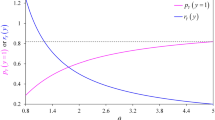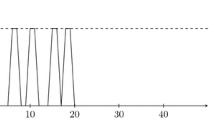Abstract
With intense competition in industry today, product quality has become a crucial factor influencing whether a firm can achieve sustainable operations and maintain competitiveness. Process capability indices are effective tools often used in manufacturing to determine whether products meets requirements, and most assume that the quality characteristics of products follow normal distributions. However, not all quality characteristics necessarily follow normal distributions; for example, product lifetime, a time-oriented quality characteristic, generally follows an exponential distribution or other associated non-normal distributions. The lifetime performance index \( C_{L} \) was thus developed to gauge the lifetime performance of products, and most related studies use the precise values of time data to evaluate product lifetime. However, in practice, measurement errors may hinder the accuracy of the observed values of quality characteristics, and the time at which the lifetime of a product ends becomes imprecise, which may result in uncertainty in the evaluation method and lead to errors in judgment. For this reason, this study thus proposes a triangular shaped fuzzy number for \( C_{L}^{*} \) to deal with imprecise data, and further develops a fuzzy testing model for lifetime performance index \( C_{L} \), to assist manufacturers in evaluating product lifetime performance more cautiously and precisely. Finally, we provide an illustration of how the proposed approach can be implemented through a numerical example.



Similar content being viewed by others
References
Besseris, G. J. (2019). Evaluation of robust scale estimators for modified Weibull process capability indices and their bootstrap confidence intervals. Computers & Industrial Engineering, 128, 135–149.
Buckley, J. J. (2005). Fuzzy statistics: hypothesis testing. Soft Computing, 9(7), 512–518.
Chang, T. C., Wang, K. J., & Chen, K. S. (2014). Sputtering process assessment of ITO film for multiple quality characteristics with one-sided and two-sided specifications. Journal of Testing and Evaluation, 42(1), 196–203.
Chen, K. S. (2019). Fuzzy testing of operating performance index based on confidence intervals. Annals of Operations Research. https://doi.org/10.1007/s10479-019-03242-x.
Chen, K. S., Chang, T. C., & Lin, Y. T. (2019). Developing an outsourcing partner selection model for process with two-sided specification using capability index and manufacturing time performance index. International Journal of Reliability, Quality and Safety Engineering, 26(3), 1950015.
Chen, K. S., Chen, S. C., & Li, R. K. (2002). Process quality analysis of products. International Journal of Advanced Manufacturing Technology, 19(8), 623–628.
Chen, K. S., Wang, K. J., & Chang, T. C. (2017). A novel approach to deriving the lower confidence limit of indices Cpu, Cpl, and Cpk in assessing process capability. International Journal of Production Research, 55(17), 4963–4981.
Chen, K. S., & Yang, C. M. (2018). Developing a performance index with a Poisson process and an exponential distribution for operations management and continuous improvement. Journal of Computational and Applied Mathematics, 343, 737–747.
Chan, L. K., Cheng, S. W., & Spiring, F. A. (1988). A new measure of process capability Cpm. Journal of Quality Technology, 20(3), 162–175.
de Felipe, D., & Benedito, E. (2017). Monitoring high complex production processes using process capability indices. International Journal of Advanced Manufacturing Technology, 93(1–4), 1257–1267.
García, V., Sánchez, J. S., Rodríguez-Picón, L. A., Méndez-González, L. C., & Ochoa-Domínguez, H. J. (2019). Using regression models for predicting the product quality in a tubing extrusion process. Journal of Intelligent Manufacturing, 30(6), 2535–2544.
Gu, K., Jia, X., Liu, H., & You, H. (2015). Yield-based capability index for evaluating the performance of multivariate manufacturing process. Quality and Reliability Engineering International, 31(3), 419–430.
Huang, J., Liu, H. C., Duan, C. Y., & Song, M. S. (2019). An improved reliability model for FMEA using probabilistic linguistic term sets and TODIM method. Annals of Operations Research. https://doi.org/10.1007/s10479-019-03447-0.
Kane, V. E. (1986). Process capability indices. Journal of Quality Technology, 18(1), 41–52.
Lawless, J. F. (2003). Statistical models and methods for lifetime data (2nd ed.). New York: Wiley.
Lakhal, L. (2009). Impact of quality on competitive advantage and organizational performance. Journal of the Operational Research Society, 60(5), 637–645.
Lee, A. H. I., Wu, C. W., & Chen, Y. W. (2016). A modified variables repetitive group sampling plan with the consideration of preceding lots information. Annals of Operations Research, 238(1–2), 355–373.
Lee, H. M., Wu, J. W., & Lei, C. L. (2013a). Assessing the lifetime performance index of exponential products with step-stress accelerated life-testing data. IEEE Transactions on Reliability, 62(1), 296–304.
Lee, W. C., Hong, C. W., & Wu, J. W. (2015). Computational procedure of performance assessment of lifetime index of normal products with fuzzy data under the type II right censored sampling plan. Journal of Intelligent and Fuzzy Systems, 28(4), 1755–1773.
Lee, W. C., Wu, J. W., Hong, C. W., Ho, K. C., & Lin, Y. C. (2013b). Performance evaluation for lifetime performance index of products for the generalized exponential distribution with upper record values. Journal of Quality, 20(3), 275–304.
Lepore, A., Palumbo, B., & Castagliola, P. (2018). A note on decision making method for product acceptance based on process capability indices Cpk and Cpmk. European Journal of Operational Research, 267(1), 393–398.
Montgomery, D. C. (1985). Introduction to statistical quality control. New York: Wiley.
Pan, Y., Li, Y., Zhang, H., & Xu, Y. (2019). Lifetime-aware FTL to improve the lifetime and performance of solid-state drives. Future Generation Computer Systems, 93, 58–67.
Pearn, W. L., Kotz, S., & Johnson, N. L. (1992). Distributional and inferential properties of process capability indices. Journal of Quality Technology, 24(4), 216–231.
Proschan, F. (1963). Theoretical explanation of observed decreasing failure rate. Technometrics, 15(3), 375–383.
Tong, L. I., Chen, K. S., & Chen, H. T. (2002). Statistical testing for assessing the performance of lifetime index of electronic components with exponential distribution. International Journal of Quality & Reliability Management, 19(7), 812–824.
Wu, C. C., Chen, L. C., & Chen, Y. J. (2016). Statistical inferences for the lifetime performance index of the products with the Gompertz distribution under censored samples. Communications in Statistics: Simulation and Computation, 45(4), 1318–1336.
Wu, C. W., Shu, M. H., & Chang, Y. N. (2018). Variable-sampling plans based on lifetime-performance index under exponential distribution with censoring and its extensions. Applied Mathematical Modelling, 55, 81–93.
Wu, M. F., Chen, H. Y., Chang, T. C., & Wu, C. F. (2019). Quality evaluation of internal cylindrical grinding process with multiple quality characteristics for gear products. International Journal of Production Research, 57(21), 6687–6701.
Wu, S. F., & Chiu, C. J. (2014). Computational testing algorithmic procedure of assessment for lifetime performance index of products with two-parameter exponential distribution based on the multiply type II censored sample. Journal of Statistical Computation and Simulation, 84(10), 2106–2122.
Wu, S. F., & Hsieh, Y. T. (2019). The assessment on the lifetime performance index of products with Gompertz distribution based on the progressive type I interval censored sample. Journal of Computational and Applied Mathematics, 351, 66–76.
Wu, S. F., & Lin, Y. P. (2016). Computational testing algorithmic procedure of assessment for lifetime performance index of products with one-parameter exponential distribution under progressive type I interval censoring. Mathematics and Computers in Simulation, 120, 79–90.
Zhou, J., Huang, H. Z., Li, Y. F., & Guo, J. (2019). A framework for fatigue reliability analysis of high-pressure turbine blades. Annals of Operations Research. https://doi.org/10.1007/s10479-019-03203-4.
Acknowledgements
The authors would like to thank the Editor and four anonymous referees for their constructive comments and careful reading, which significantly improved the presentation of this paper. The earlier version of this paper was presented at the 25th ISSAT International Conference on Reliability and Quality in Design (RQD), August 1-3, 2019, held in Las Vegas, USA. This work was partially supported by the Ministry of Science and Technology Taiwan [Grant Number MOST 108-2218-E-025-003-].
Author information
Authors and Affiliations
Corresponding author
Additional information
Publisher's Note
Springer Nature remains neutral with regard to jurisdictional claims in published maps and institutional affiliations.
Appendix: Triangular shaped fuzzy number of \( C_{L}^{*} \)
Appendix: Triangular shaped fuzzy number of \( C_{L}^{*} \)
From Eq. (13), we can know that \( W = {{V\left( Z \right)} \mathord{\left/ {\vphantom {{V\left( Z \right)} \lambda }} \right. \kern-0pt} \lambda } \) is distributed as \( Gamma\left( {n,1} \right) \). In view of this, we can further derive the following:
Thus, the \( 100\left( {1 - \alpha } \right)\% \) confidence interval of \( C_{L} \) is \( \left[ {LC_{L} ,UC_{L} } \right] \), where
In adopting Buckley’s approach (Buckley 2005), the α-cuts of the triangular shaped fuzzy number \( \tilde{C}_{L}^{*} \) are \( \tilde{C}_{L}^{*} \left[ \alpha \right] = \left[ {C_{L1}^{*} \left( \alpha \right),C_{L2}^{*} \left( \alpha \right)} \right] \), as shown below:
where
Furthermore, for \( 0. 0 1\le \alpha \le 1 \), starting at 0.01 is arbitrary. It is worth noting that \( C_{L1}^{*} \left( 1 \right) = C_{L2}^{*} \left( 1 \right) \ne C_{L}^{*} \) when \( \alpha = 1 \). This leads to considerable inconvenience for management in evaluation of lifetime performance. To resolve this, let \( C_{L}^{\prime *} \) be defined as follows:
Thus, the \( \alpha {\text{ - cuts}} \) of the triangular shaped fuzzy number \( \tilde{C}_{L}^{*} \) after transforming variable can be expressed as follows:
where
From the above equation, we can see that \( C_{L1}^{\prime *} \left( 1 \right) = C_{L2}^{\prime *} \left( 1 \right) = C_{L}^{*} \) when \( \alpha = 1 \). Obviously, the triangular shaped fuzzy number of \( C_{L}^{*} \) after transforming variable can further be expressed as follows:
where
Rights and permissions
About this article
Cite this article
Chen, KS., Chang, TC. Fuzzy testing model for the lifetime performance of products under consideration with exponential distribution. Ann Oper Res 312, 87–98 (2022). https://doi.org/10.1007/s10479-020-03578-9
Published:
Issue Date:
DOI: https://doi.org/10.1007/s10479-020-03578-9




